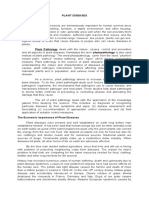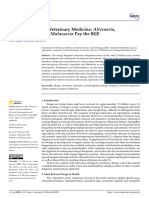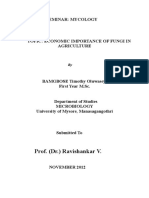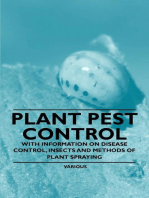Fungi and Disease
Fungi and Disease
Uploaded by
harold_gravity9885Copyright:
Available Formats
Fungi and Disease
Fungi and Disease
Uploaded by
harold_gravity9885Original Description:
Copyright
Available Formats
Share this document
Did you find this document useful?
Is this content inappropriate?
Copyright:
Available Formats
Fungi and Disease
Fungi and Disease
Uploaded by
harold_gravity9885Copyright:
Available Formats
WF05
Fungi and Disease
Recap. . . . . . .
Bacteria, fungi and viruses are all micro organisms. We learnt last lesson that some fungal species are beneficial to humans in the food industry and in medicine production. However, some fungal species can cause disease along with bacteria and viruses. Micro organisms that cause disease are called pathogens.
Lets Focus on Fungi
Certain fungi have the ability to cause diseases in humans, plants and animals. When looking at plant pathogens its important to remember that some parts of the plant are above ground stems and leaves and other parts are below ground roots. So, it makes sense that airborne pathogenic fungi infect the stems and leaves and soil borne pathogenic fungi infect plant roots. Plant diseases have some very strange names! They are given names like: Blights Rusts Smuts Mildews Most of these names come from old descriptions of the effect on the crop and were given to the disease long before its cause was known. Mildew is a cottony covering on the leaf (on which dew forms readily). A crop that looks sick and dying might be described as being blighted; plants covered in red masses (actually fungal spores) as being rusted; or if covered in black deposits (spores again) like soot, then its a smut or a tarspot.
This document may be copied freely for educational purposes only.
All rights reserved for commercial use. Text Charlotte Quinn 2005; design and production David Moore 2005.
WF05
Some Examples of Plant Diseases
This is a tarspot disease of sycamore leaves. Caused by a fungus called Rhytisma acerinum which is very common and widely distributed. You can see this on sycamore leaves throughout the year.
David Moore
Paul Dyer
This is eyespot disease on wheat stems, caused by a fungus with the wonderful name of Pseudocercosporella herpotrichoides. Its a serious disease of cereals because it survives from year to year on stubble debris, and can even survive being ploughed under and ploughed up again the following season.
This is the rust disease of wild and cultivated daisies caused by Puccinia distincta. An epidemic of this disease started in the mid1990s and spread from Australia, through Europe, and into North America. In many places, ornamental daisies can no longer be grown unless they are protected by fungicide sprays.
Roland Weber
This document may be copied freely for educational purposes only.
All rights reserved for commercial use. Text Charlotte Quinn 2005; design and production David Moore 2005.
WF05
Human diseases caused by fungi are called mycoses. The diseases are divided into three groups depending on where they occur on our body. These groups are: Superficial Subcutaneous These infect the skin, nails and hair. These infect the deep layers of the skin. These are the most severe fungal diseases. An unsuspecting person may inhale the pathogenic fungal spores. Some spores stay in the lungs and grow while others enter the bloodstream, travel around the body and infect other organs.
Systemic
Most fungal infections are due to opportunistic pathogens; these affect people who are already ill or have a suppressed immune system (e.g. in patients who have been given an organ transplant, or in AIDS patients). In a perfectly healthy person the fungus would not normally cause disease. True pathogens can cause disease in even the healthiest person. Like bacteria, fungi can produce toxins. Fungal toxins are called mycotoxins and the diseases they cause are called mycotoxicoses. Several food items are particularly susceptible to fungal disease including bread, dried pasta, peanuts and stored grains and cereals. All of these are dry foods which should be stored in dry conditions. When stored in the wrong conditions of high temperature and high humidity, mycotoxins can be found as a result of fungal (mould) growth in the stored material. The most widespread and dangerous of these are the aflatoxins produced by the mould called Aspergillus flavus. These are carcinogenic, which means they can cause cancer. Aflatoxins pose a serious threat to both humans and domestic animals because the mould grows on poorly-stored grain and animal feed. When eaten, the toxin is stored in the liver where it can eventually cause hepatitis and liver cancer.
This document may be copied freely for educational purposes only.
All rights reserved for commercial use. Text Charlotte Quinn 2005; design and production David Moore 2005.
WF05
Some Examples of Human Diseases
Ringworm is not a worm, but a common fungus infection of the skin. The fungus (often one called Microsporum) does not invade living tissue but the fungus and its metabolic products cause inflammation. This 5-week old baby caught the disease from contact with Image courtesy of www.doctorfungus.org 2005 the familys pet cats. Epidermophyton floccosum causes athletes foot in humans usually in the web area between toes and is common in shoewearing people because its favoured by warm, humid conditions. It can also affect the hand and other areas of the body, Image courtesy of www.doctorfungus.org 2005 and here is attacking toe-nails. This is a Madurella mycetoma on a patients limb. This disease occurs all over the world, but is most common in tropical and sub-tropical regions. It is caused by a number of fungi including Madurella, Acremonium, Curvularia, Fusarium and Aspergillus.
Image courtesy of www.doctorfungus.org 2005
These are skin ulcers of a patient suffering from blastomycosis (caused by Blastomyces dermatidis). The disease starts in the lungs when spores are inhaled, and then spreads to other organs.
Image courtesy of www.doctorfungus.org 2005
This document may be copied freely for educational purposes only.
All rights reserved for commercial use. Text Charlotte Quinn 2005; design and production David Moore 2005.
WF05
History Lesson!
An important example that demonstrates just how devastating pathogens of our crops can be is the Irish Potato Famine of 1845 46. The organism responsible was a relative of the fungi called potato blight or Phytophthora infestans even the scientific name means infesting plant destroyer! The whole of Europe was affected with the disease (which was introduced on plants imported from the Americas) but Ireland suffered more because the poorest people lived entirely on a diet of potatoes. English labourers were less affected because they had cereal foods in their diet and cereal crops were not affected by the disease. For the majority of the Irish, though, if there were no potatoes they starved. Sadly, from 1845 to 1860 a staggering 1 million people died as a direct consequence of the famine, and over 2 million emigrated (many to the USA). So what can we learn from this tragic incident? Grow more than one crop. Growing a single crop plant over vast areas (called monoculture) encourages disease to spread rapidly. Also, populations should not be entirely dependent on a single source of food. Use of fungicides will prevent or at least control disease. Of course, in the mid-nineteenth century the cause of potato blight was not known because the germ theory of disease (that is, the idea that diseases are caused by infections) had not even been suggested in 1845. Store in the correct conditions: this means proper control of humidity, oxygen and temperature. It doesnt have to mean high technology whats required is good aeration and careful protection from rain and ground water. Weather conditions play in important part in the spread of crop disease.
This document may be copied freely for educational purposes only.
All rights reserved for commercial use. Text Charlotte Quinn 2005; design and production David Moore 2005.
You might also like
- Case Study - The Raffles Hotel SingaporeDocument4 pagesCase Study - The Raffles Hotel Singaporejejoullie162No ratings yet
- Microbes in Daily LifeDocument36 pagesMicrobes in Daily LifeSusheel Gupta71% (7)
- Mind Web Academy - Booster 3Document8 pagesMind Web Academy - Booster 3Charis Gutierrez RodriguezNo ratings yet
- Alchemical HillmanDocument171 pagesAlchemical HillmanSilverio PelayoNo ratings yet
- MicroparaDocument5 pagesMicroparaNathaniel BudayNo ratings yet
- presterl2018Document5 pagespresterl2018lakshman kumarNo ratings yet
- Microorganisms PPT3Document24 pagesMicroorganisms PPT3meghaduttan4bNo ratings yet
- Common Spesies of MoldDocument4 pagesCommon Spesies of Moldn4zer100% (2)
- Module 5-Breeding For Disease ResistanceDocument33 pagesModule 5-Breeding For Disease ResistanceYrlânia GuerraNo ratings yet
- PLPA 301 Lecture NotesDocument21 pagesPLPA 301 Lecture NotesLauren BoylesNo ratings yet
- Adult Care Level 3 - Unit 11 Activities AnsweredDocument10 pagesAdult Care Level 3 - Unit 11 Activities AnsweredkktuNo ratings yet
- PP-605 Notes EpidemiologyDocument20 pagesPP-605 Notes EpidemiologyaklockcorelavellNo ratings yet
- MoldsDocument25 pagesMoldsayesha baberNo ratings yet
- Plant Pathology Practical Y4Document45 pagesPlant Pathology Practical Y4Duncan GitongaNo ratings yet
- PlantsDocument4 pagesPlantsRos HartNo ratings yet
- Hookworm RephraseDocument6 pagesHookworm Rephrasecooky maknaeNo ratings yet
- 15 Pathogenic FungiDocument8 pages15 Pathogenic FungiSathish KumarNo ratings yet
- 07 - Chapter 1Document85 pages07 - Chapter 1Pravallika ManneNo ratings yet
- Project Report On Human Diseases: PathogenDocument8 pagesProject Report On Human Diseases: PathogenPandit Shikhar TripathiNo ratings yet
- Advanced Crop Protection Hand-OutsDocument21 pagesAdvanced Crop Protection Hand-OutsDaphne Cuaresma100% (1)
- Pigeon Associated People Diseases: Digitalcommons@University of Nebraska - LincolnDocument4 pagesPigeon Associated People Diseases: Digitalcommons@University of Nebraska - LincolnBIOSPIN NOVI SADNo ratings yet
- 7-12-2013 DR - Asif Iqbal 1Document66 pages7-12-2013 DR - Asif Iqbal 1Dini Permata SariNo ratings yet
- Allergy To Fungi in Veterinary MedicineDocument13 pagesAllergy To Fungi in Veterinary Medicineconsejocomunallasoledad2022No ratings yet
- PathoDocument189 pagesPathochristopher suarezNo ratings yet
- Control of Health Hazards Associated With Bird and Bat DroppingsDocument7 pagesControl of Health Hazards Associated With Bird and Bat DroppingsCaleb VoosNo ratings yet
- Fungal Pathogenesis Lecture NotesDocument4 pagesFungal Pathogenesis Lecture NotesElla BoyceNo ratings yet
- 30 Chicken Diseases Every Farmer Should KnowDocument104 pages30 Chicken Diseases Every Farmer Should KnowHadrien FaryalaNo ratings yet
- Lec 15Document37 pagesLec 15rangalokesh143No ratings yet
- bio-and-stsDocument16 pagesbio-and-stsfidessophia.ambatNo ratings yet
- Food Poisoning by SorsDocument9 pagesFood Poisoning by SorsnanasunNo ratings yet
- Chapter 06 Turning The TablesDocument7 pagesChapter 06 Turning The TablesEved1981 superrito.comNo ratings yet
- Plant Diseases and Epidemiology-Paul OpioDocument7 pagesPlant Diseases and Epidemiology-Paul OpioPAUL OPIONo ratings yet
- Plant - Pathogen Interaction & Disease Development - ppt-2003Document91 pagesPlant - Pathogen Interaction & Disease Development - ppt-2003lordniklaus100% (8)
- Terms and Concepts in Plant PathologyDocument48 pagesTerms and Concepts in Plant PathologytripsNo ratings yet
- Lest We ForgetDocument2 pagesLest We Forgetapi-218248245No ratings yet
- Anti-Fungal Drugs - Summer 2023Document60 pagesAnti-Fungal Drugs - Summer 2023NAYEEMA JAMEEL ANUVANo ratings yet
- Malaria: Its Causes, Treatment and Methods of PreventionDocument6 pagesMalaria: Its Causes, Treatment and Methods of PreventionAaliyaan KhanNo ratings yet
- MODULE II - Crop ProtectionDocument10 pagesMODULE II - Crop ProtectionAmpee Aura Almeria GonzalesNo ratings yet
- Learning Act 3Document3 pagesLearning Act 3larnieestebanNo ratings yet
- Economic Importance of Fungi in AgricultDocument13 pagesEconomic Importance of Fungi in AgricultSai BharathNo ratings yet
- Crp304 Channel 1Document4 pagesCrp304 Channel 1sophiavanessa011No ratings yet
- Microorganisms: Friends and FoeDocument32 pagesMicroorganisms: Friends and FoePROYASH ASSAM100% (1)
- Objectives:: Pediculus Humanus Capitis Female, Pediculus Humanus Capitis Male, Cimex LectulariusDocument13 pagesObjectives:: Pediculus Humanus Capitis Female, Pediculus Humanus Capitis Male, Cimex LectulariusRaymond Martin CorpusNo ratings yet
- Diseases and Mosquito Biology ProjectDocument8 pagesDiseases and Mosquito Biology ProjectCurnel MilletteNo ratings yet
- Micro Organisms 1Document5 pagesMicro Organisms 1kpsivamsportsNo ratings yet
- Assignment CPTDocument9 pagesAssignment CPTparameswar jenaNo ratings yet
- Yellow FeverDocument31 pagesYellow FeverVibha AvasthiNo ratings yet
- Infection ControlDocument71 pagesInfection ControlARra Odeza100% (1)
- Importence of FungiDocument5 pagesImportence of Fungiathelfled12No ratings yet
- Plant PathologyDocument251 pagesPlant PathologyAngelyn RodulloNo ratings yet
- Plant Pest Control - With Information on Disease Control, Insects and Methods of Plant SprayingFrom EverandPlant Pest Control - With Information on Disease Control, Insects and Methods of Plant SprayingNo ratings yet
- Post Harvest Diseases of CearealsDocument6 pagesPost Harvest Diseases of CearealsZahwa AshfaqueNo ratings yet
- 5th Semester Plant Pathology by Laxman AryalDocument79 pages5th Semester Plant Pathology by Laxman AryalBinod BhandariNo ratings yet
- Pictures 24 Fungi)Document6 pagesPictures 24 Fungi)Karshey Alagad ObutNo ratings yet
- Diseases (Unread 16)Document3 pagesDiseases (Unread 16)francisNo ratings yet
- Kenyatta University: School of Pure and Applied Science Department of Biochemistry, Biotechnology and MicrobiologyDocument7 pagesKenyatta University: School of Pure and Applied Science Department of Biochemistry, Biotechnology and MicrobiologyQüêen ØlïvîãhNo ratings yet
- Eet 311-1Document13 pagesEet 311-1apijeharrisonNo ratings yet
- Emmy Blaq PPT-1Document13 pagesEmmy Blaq PPT-1ejohn8340No ratings yet
- Mycotoxogenic MoldsDocument40 pagesMycotoxogenic MoldsAimen fatimaNo ratings yet
- Unit 1 PDFDocument13 pagesUnit 1 PDFSantosh KhatiwadaNo ratings yet
- Viral Vistas: Insights into Infectious Diseases: The Invisible War: Decoding the Game of Hide and Seek with PathogensFrom EverandViral Vistas: Insights into Infectious Diseases: The Invisible War: Decoding the Game of Hide and Seek with PathogensNo ratings yet
- Servqual PHD ThesisDocument40 pagesServqual PHD Thesisharold_gravity9885No ratings yet
- Servqual PHD ThesisDocument40 pagesServqual PHD Thesisharold_gravity9885No ratings yet
- Read:: Winners Of: ICT Enabled University Award E - India - 2009 Manthan Award - 2009Document1 pageRead:: Winners Of: ICT Enabled University Award E - India - 2009 Manthan Award - 2009harold_gravity9885No ratings yet
- Gujarat Technological University: Subject Code: Date:01/01/2019 Subject Name: Time: 10:30 AM To 01:30 PM Total Marks: 70Document3 pagesGujarat Technological University: Subject Code: Date:01/01/2019 Subject Name: Time: 10:30 AM To 01:30 PM Total Marks: 70harold_gravity9885No ratings yet
- Gujarat Technological University: Master of Business AdministrationDocument3 pagesGujarat Technological University: Master of Business Administrationharold_gravity9885No ratings yet
- General Knowledge: Geographical Sobriquets (Nickname) Nickname NameDocument1 pageGeneral Knowledge: Geographical Sobriquets (Nickname) Nickname Nameharold_gravity9885No ratings yet
- My Student Life in UniversityDocument1 pageMy Student Life in Universityharold_gravity9885No ratings yet
- Admission Events For GCET-2009Document1 pageAdmission Events For GCET-2009harold_gravity9885No ratings yet
- Relevance of Non-ViolenceDocument2 pagesRelevance of Non-Violenceharold_gravity9885No ratings yet
- CommunicationDocument35 pagesCommunicationNeeti SaxenaNo ratings yet
- Chapter 38: Human Diseases Caused by VirusesDocument13 pagesChapter 38: Human Diseases Caused by Virusesharold_gravity9885No ratings yet
- Difference Between Spillback and Minimum Circulation Line - Google SearchDocument1 pageDifference Between Spillback and Minimum Circulation Line - Google SearchGourav KumarNo ratings yet
- RR-US590 RR-US570: Operating Instructions IC RecorderDocument44 pagesRR-US590 RR-US570: Operating Instructions IC RecorderjaureguinievesNo ratings yet
- Wiley - Momentum, Direction, and Divergence - 978-0-471-02729-4Document3 pagesWiley - Momentum, Direction, and Divergence - 978-0-471-02729-4Alex BrightNo ratings yet
- Physics Lab Manual - Class 11 Activity 1Document2 pagesPhysics Lab Manual - Class 11 Activity 1masterjedi1008No ratings yet
- Allgon - 7282.03Document1 pageAllgon - 7282.03faapctbaNo ratings yet
- Practice Test 1: Questions 1-6Document10 pagesPractice Test 1: Questions 1-6hoang trinh100% (1)
- Congress of Vienna Reading Activity - EditedDocument7 pagesCongress of Vienna Reading Activity - EditedNicolas OsbornNo ratings yet
- Chapter 10 Variable CostingDocument15 pagesChapter 10 Variable CostingAbby Manila100% (3)
- Summer A2 SyllabusDocument4 pagesSummer A2 Syllabusapi-277763254No ratings yet
- 2005 Canlii 19664Document30 pages2005 Canlii 19664Chris BamfordNo ratings yet
- 123 AwatgDocument27 pages123 AwatgPrasadi IidiotNo ratings yet
- Object-Oriented Programming (CS F213) : BITS PilaniDocument14 pagesObject-Oriented Programming (CS F213) : BITS PilaniSAURABH MITTALNo ratings yet
- Verituner For Iphone User GuideDocument41 pagesVerituner For Iphone User Guidefaguilerat958650% (2)
- DRL Housing Application Booklet 9.15.17 PDFDocument15 pagesDRL Housing Application Booklet 9.15.17 PDFHridi RahmanNo ratings yet
- Bank Mpcb2Document5 pagesBank Mpcb2myungjin mjinNo ratings yet
- Project Execution Management (Pem) System: Business PlanDocument10 pagesProject Execution Management (Pem) System: Business PlanFarly VergelNo ratings yet
- 114 MCQs +Mid+Final PTech Syllabus-Merged-MergedDocument798 pages114 MCQs +Mid+Final PTech Syllabus-Merged-Mergedkamran.ghafoor.302100% (1)
- Pearlbrook Rules (WEB)Document8 pagesPearlbrook Rules (WEB)Unoque NoesyoNo ratings yet
- Reading Card Feb 10 - CompressedDocument401 pagesReading Card Feb 10 - CompressedfgissemaNo ratings yet
- Kino Balog - WEEK 2 - ACTIVITIESDocument4 pagesKino Balog - WEEK 2 - ACTIVITIESPrincess Therese CañeteNo ratings yet
- Tesla Data Analyst CVDocument1 pageTesla Data Analyst CVdiegoNo ratings yet
- The Factors Influencing The Career Choices of Students of Institute of Business Management-The Making of Future Employees or EmployersDocument10 pagesThe Factors Influencing The Career Choices of Students of Institute of Business Management-The Making of Future Employees or EmployersAgha Muhammad MujahidNo ratings yet
- PAS Ganjil X B.Inggris Wajib 23Document5 pagesPAS Ganjil X B.Inggris Wajib 23Adam purwanaNo ratings yet
- Instructions and Warnings For Installation and Use Nice Spin23r10 Bidi Set For Garage Doors PDFDocument12 pagesInstructions and Warnings For Installation and Use Nice Spin23r10 Bidi Set For Garage Doors PDFANTENo ratings yet
- Anemia and AnesthesiaDocument11 pagesAnemia and AnesthesialhalamNo ratings yet
- Lesson-2 Descriptive-Statistics LectureDocument27 pagesLesson-2 Descriptive-Statistics LectureD E L INo ratings yet
- Mixed Costing Configuration DocumentDocument23 pagesMixed Costing Configuration DocumentNadeem KhanNo ratings yet



































































































